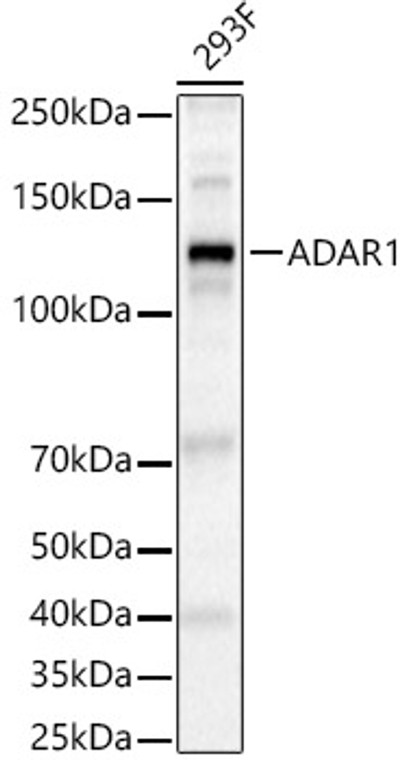| Host: |
Rabbit |
| Applications: |
WB/IHC-P/IF/ICC/ELISA |
| Reactivity: |
Human/Mouse/Rat |
| Note: |
STRICTLY FOR FURTHER SCIENTIFIC RESEARCH USE ONLY (RUO). MUST NOT TO BE USED IN DIAGNOSTIC OR THERAPEUTIC APPLICATIONS. |
| Clonality: |
Polyclonal |
| Conjugation: |
Unconjugated |
| Isotype: |
IgG |
| Formulation: |
PBS with 0.02% Sodium Azide, 50% Glycerol, pH 7.3. |
| Purification: |
Affinity purification |
| Concentration: |
Lot specific |
| Dilution Range: |
WB:1:500-1:1000IHC-P:1:50-1:200IF/ICC:1:50-1:200ELISA:Recommended starting concentration is 1 Mu g/mL. Please optimize the concentration based on your specific assay requirements. |
| Storage Instruction: |
Store at-20°C for up to 1 year from the date of receipt, and avoid repeat freeze-thaw cycles. |
| Gene Symbol: |
ADAR |
| Gene ID: |
103 |
| Uniprot ID: |
DSRAD_HUMAN |
| Immunogen Region: |
212-228 |
| Specificity: |
A synthetic peptide corresponding to a sequence within amino acids 200-299 of human ADAR11 (NP_001102.2). |
| Immunogen Sequence: |
STQAWNQHSGVVRPDGHSQG APNSDPSLEPEDRNSTSVSE DLLEPFIAVSAQAWNQHSGV VRPDSHSQGSPNSDPGLEPE DSNSTSALEDPLEFLDMAEI KEKICDYLFNVSDSSALNLA KNIGLTKARDINAVLIDMER QGDVYRQGTTPPIWHLTDKK RERMQIKRNTNSVPETAPAA IPETKRNAEFLTCNIPTSNA SNNMVTTEKVENGQEPVIKL ENRQEARPEPARLKPPVHY |
| Tissue Specificity | Ubiquitously expressed, highest levels were found in brain and lung. Isoform 5 is expressed at higher levels in astrocytomas as compared to normal brain tissue and expression increases strikingly with the severity of the tumor, being higher in the most aggressive tumors. |
| Post Translational Modifications | Sumoylation reduces RNA-editing activity. |
| Function | Catalyzes the hydrolytic deamination of adenosine to inosine in double-stranded RNA (dsRNA) referred to as A-to-I RNA editing. This may affect gene expression and function in a number of ways that include mRNA translation by changing codons and hence the amino acid sequence of proteins since the translational machinery read the inosine as a guanosine.pre-mRNA splicing by altering splice site recognition sequences.RNA stability by changing sequences involved in nuclease recognition.genetic stability in the case of RNA virus genomes by changing sequences during viral RNA replication.and RNA structure-dependent activities such as microRNA production or targeting or protein-RNA interactions. Can edit both viral and cellular RNAs and can edit RNAs at multiple sites (hyper-editing) or at specific sites (site-specific editing). Its cellular RNA substrates include: bladder cancer-associated protein (BLCAP), neurotransmitter receptors for glutamate (GRIA2) and serotonin (HTR2C) and GABA receptor (GABRA3). Site-specific RNA editing of transcripts encoding these proteins results in amino acid substitutions which consequently alters their functional activities. Exhibits low-level editing at the GRIA2 Q/R site, but edits efficiently at the R/G site and HOTSPOT1. Its viral RNA substrates include: hepatitis C virus (HCV), vesicular stomatitis virus (VSV), measles virus (MV), hepatitis delta virus (HDV), and human immunodeficiency virus type 1 (HIV-1). Exhibits either a proviral (HDV, MV, VSV and HIV-1) or an antiviral effect (HCV) and this can be editing-dependent (HDV and HCV), editing-independent (VSV and MV) or both (HIV-1). Impairs HCV replication via RNA editing at multiple sites. Enhances the replication of MV, VSV and HIV-1 through an editing-independent mechanism via suppression of EIF2AK2/PKR activation and function. Stimulates both the release and infectivity of HIV-1 viral particles by an editing-dependent mechanism where it associates with viral RNAs and edits adenosines in the 5'UTR and the Rev and Tat coding sequence. Can enhance viral replication of HDV via A-to-I editing at a site designated as amber/W, thereby changing an UAG amber stop codon to an UIG tryptophan (W) codon that permits synthesis of the large delta antigen (L-HDAg) which has a key role in the assembly of viral particles. However, high levels of ADAR1 inhibit HDV replication. |
| Protein Name | Double-Stranded Rna-Specific Adenosine DeaminaseDrada136 Kda Double-Stranded Rna-Binding ProteinP136Interferon-Inducible Protein 4Ifi-4K88dsrbp |
| Database Links | Reactome: R-HSA-75102Reactome: R-HSA-77042Reactome: R-HSA-909733Reactome: R-HSA-9833482 |
| Cellular Localisation | Isoform 1: CytoplasmNucleusShuttles Between The Cytoplasm And NucleusNuclear Import Is Mediated By Tnpo1Isoform 5: CytoplasmNucleolusPredominantly Nuclear But Can Shuttle Between Nucleus And CytoplasmTnpo1 Can Mediate Its Nuclear Import Whereas Xpo5 Can Mediate Its Nuclear Export |
| Alternative Antibody Names | Anti-Double-Stranded Rna-Specific Adenosine Deaminase antibodyAnti-Drada antibodyAnti-136 Kda Double-Stranded Rna-Binding Protein antibodyAnti-P136 antibodyAnti-Interferon-Inducible Protein 4 antibodyAnti-Ifi-4 antibodyAnti-K88dsrbp antibodyAnti-ADAR antibodyAnti-ADAR1 antibodyAnti-DSRAD antibodyAnti-G1P1 antibodyAnti-IFI4 antibody |
Information sourced from Uniprot.org
12 months for antibodies. 6 months for ELISA Kits. Please see website T&Cs for further guidance













